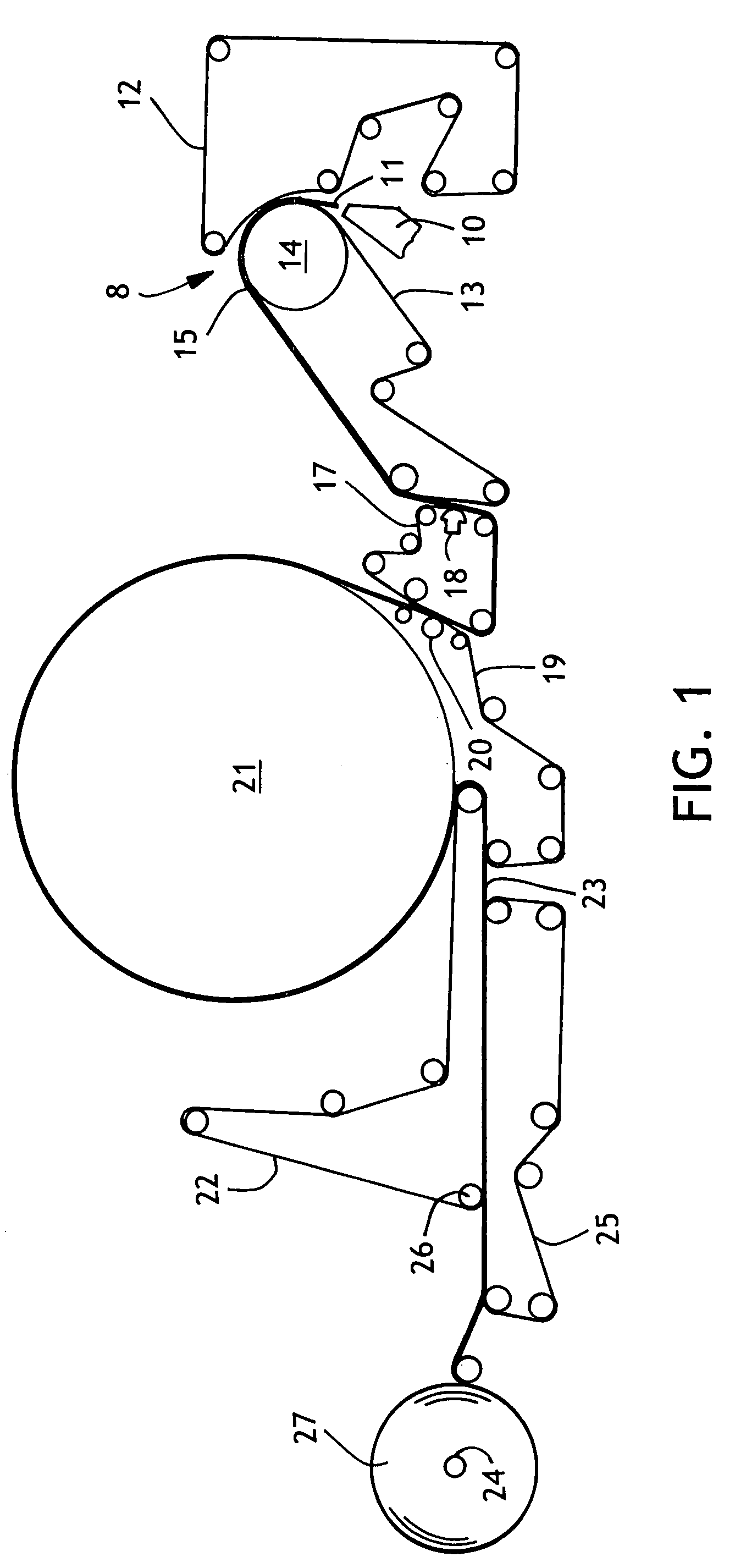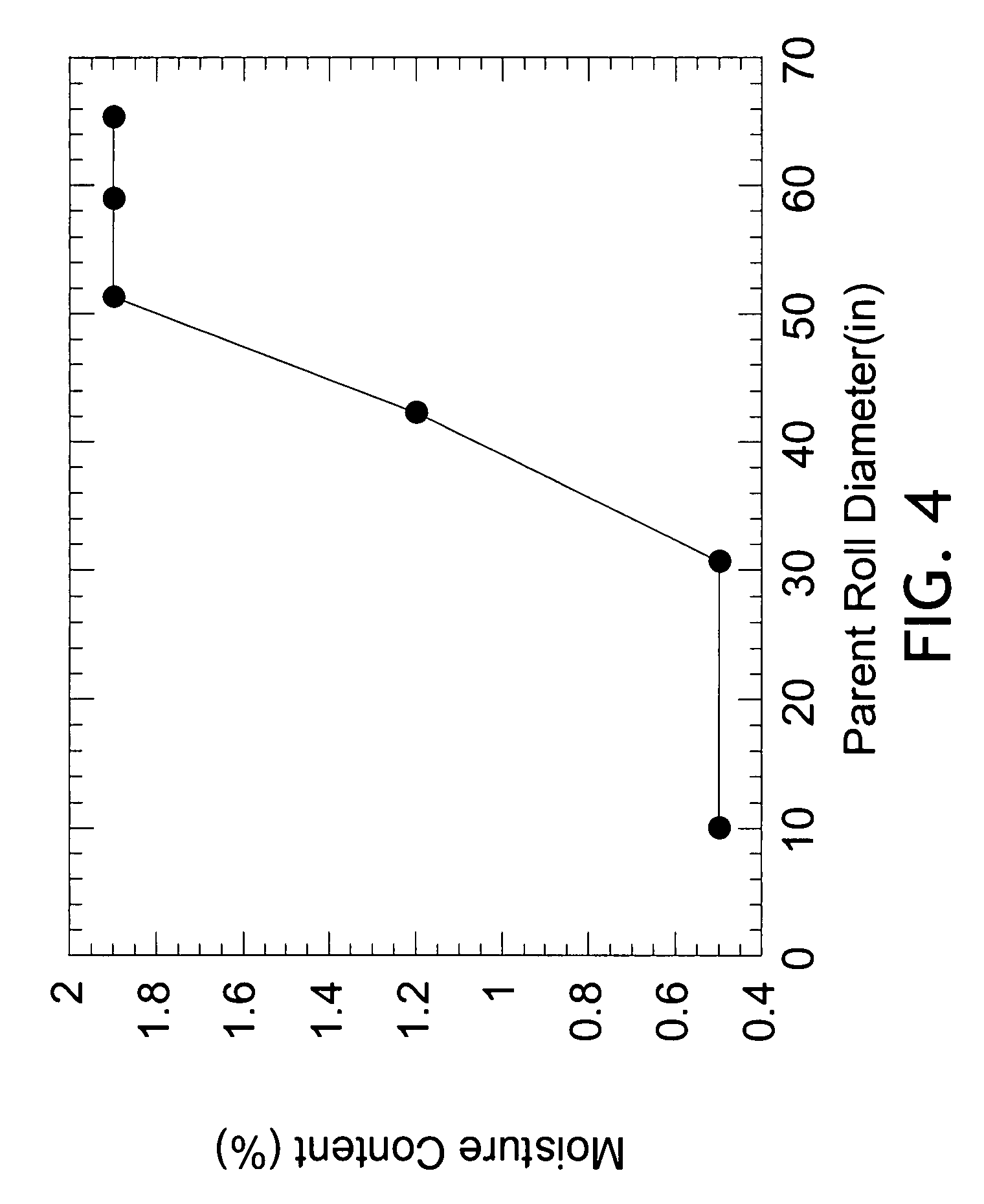Tissue machine parent roll having variable intrinsic sheet dryness
a tissue machine and parent roll technology, applied in the field of tissue machine parent roll having variable intrinsic sheet dryness, can solve the problems of roll that cannot be properly unwound in downstream operations, sheet caliper variation, product quality issues, etc., and achieve the effect of reducing the ability of tissue sheets to resist compression, low moisture content, and high moisture conten
- Summary
- Abstract
- Description
- Claims
- Application Information
AI Technical Summary
Benefits of technology
Problems solved by technology
Method used
Image
Examples
example 3 (
Invention)
Parent Roll with 0.5-2 Percent Moisture Gradient
[0046]The processes of Examples 1 and 2 were combined to produce a parent roll with a 0.5-2 percent moisture gradient. Specifically, the production of roughly the first half of the parent roll was done according to Example 1 with all vacuum boxes active. This yielded a parent roll with a 0.5 percent sheet moisture content in the core region. When the parent roll reached a diameter of roughly 30 inches, one vacuum pump was turned off in accordance with Example 2. As the reduction in dewatering vacuum was instantaneous, a relatively sharp step-wise moisture transition was achieved. At this point the dried sheet moisture increased to 2 percent and the remainder of the parent roll (70 inches in diameter) was built using this operating condition. In this manner, a parent roll with a sheet moisture of about 0.5 percent in the core region and about 2 percent moisture in the outer region of the parent roll was produced. The results a...
examples 4-6
Calendering Sheets from Examples 1-3
[0051]The parent rolls from Examples 1-3 were wrapped in plastic to minimize uptake of moisture from the environment and stored for 7 days. After storage, the moisture content was measured using the equilibrium relative humidity probe. The rolls were then calendered between a steel roll and a relatively soft (40 P&J Hardness) rubber-coated roll at a rate of about 400 feet per minute. The rolls were pressed together with a 45 pounds per lineal inch loading. The calendered sheet was then rewound into approximately 4.5 inches diameter finished product bath tissue rolls. The caliper of the sheets in the finished product rolls was measured immediately after production. The loss in caliper during calendering is set forth in FIG. 6 and correlated well with the post-storage moisture content of the sheet and is described well by the expression:
[0052]Cf=Cc(2.6PLI)0.14+3.7m(4)
[0053]where “Cf” is the final caliper in 0.001 inch units, “Cc” is the caliper a...
PUM
| Property | Measurement | Unit |
|---|---|---|
| diameter | aaaaa | aaaaa |
| diameter | aaaaa | aaaaa |
| diameter | aaaaa | aaaaa |
Abstract
Description
Claims
Application Information
 Login to View More
Login to View More - R&D
- Intellectual Property
- Life Sciences
- Materials
- Tech Scout
- Unparalleled Data Quality
- Higher Quality Content
- 60% Fewer Hallucinations
Browse by: Latest US Patents, China's latest patents, Technical Efficacy Thesaurus, Application Domain, Technology Topic, Popular Technical Reports.
© 2025 PatSnap. All rights reserved.Legal|Privacy policy|Modern Slavery Act Transparency Statement|Sitemap|About US| Contact US: help@patsnap.com



